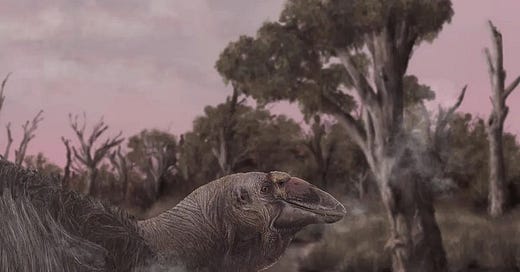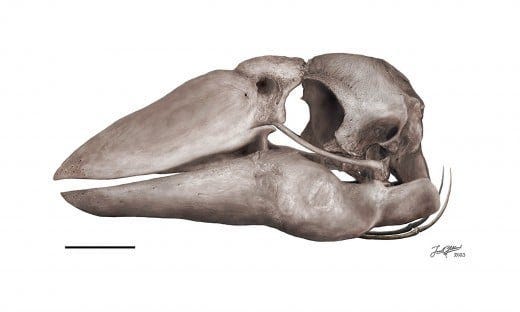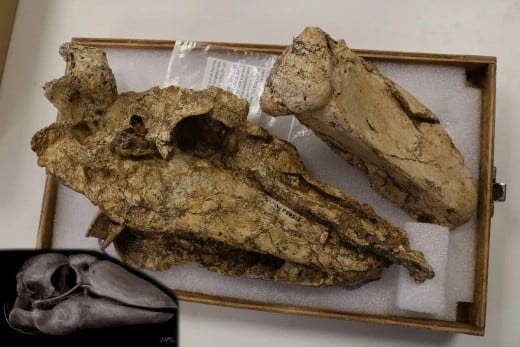Giga-Goose: An Australian Giant
Fossils reveal new information about the last of Australia’s thunder birds
A Mysterious Prehistoric Bird
In 1896, a mostly complete skeleton of a large flightless bird was discovered in South Australia. These fossils would turn out to be an important find since they introduced a previously unknown species of bird to science.
Yet while the body was well-preserved, the skull was considerably less so, making it difficult to determine just where this animal fit within the avian family tree. The skull was simply too damaged to be useful for identification.
“The skull is what will retain those more complex family indicators,” explained evolutionary biologist Phoebe McInerney. “So for the last 120 or so years we have been looking for better skull fossils.”
The mystery species was first described in 1913. Genyornis newtoni—this scientific name combines the Greek for “jaw bird” with the surname of English ornithologist Alfred Newton—was a giant, standing at up to 7.4 feet tall and weighing in at 500 lbs.
Fossils Reveal a Unique Aquatic Bird
The face of G. newtoni would eventually be revealed after the discovery of partial skulls belonging to the species at Lake Callabonna in South Australia. From 2013–2019, a team from Australia’s Flinders University carefully unearthed these fossils, and what they learned from them was fascinating.
For several decades, the species had been the subject of speculation, with some hypothesizing that it had been a massive emu, while others guessed that it could have been more closely related to a chicken. However, as it turned out, G. newtoni was neither a chicken nor an emu.
It possessed a rather unique face, but one that strongly hinted at an aquatic lifestyle, with features similar to those of a goose or a duck, earning it the memorable nickname, “giga-goose.”
However the journey to classify them wasn’t quite that simple. This aquatic species stands out among the water birds. Much like other Australian animals, the giga-goose had some unusual adaptations.
McInerney, the study’s lead author, explained:
“The exact relationships of Genyornis within this group have been complicated to unravel, however, with this new skull we have started to piece together the puzzle which shows, simply put, this species to be a giant goose … Seeing the skull fully out of the matrix and free from the dirt around it was definitely a ‘wow’ event. We weren’t really sure what to expect, and we kept finding new parts of the skull that were hidden within.”
The giga-goose belongs to the order Anseriformes—the group of birds known as waterfowl.
“There’s no close analogue for these birds,” noted paleoecologist Nic Rawlence. “They are a truly unique Australian island experiment, as unique as koalas and kangaroos. With this amazing new discovery, we can now actually start to reconstruct the evolution and the behavior of this animal.”
Diet & Lifestyle of Giga-Geese
Unsurprisingly, some aspects of G. newtoni’s morphology indicate that it spent a lot of time in or near water, such as the intricate structure of its ears, which would have prevented water from entering when its head was submerged.
Additionally, their bill appears to have evolved to feed on the fruit and leaves of plants found along the water’s edge. This bird likely spent a great deal of time in wetlands and other freshwater habitats. Their strong jaws would have allowed them to consume a wide range of plant life.
“Genyornis newtoni had a tall and mobile upper jaw,” stated McInerney, “like a parrot but shaped like a goose, a wide gape, strong bite force, and the ability to crush soft plants and fruit on the roof of their mouth.”
Why Did They Die Out?
The giga-goose vanished from the Australian landscape approximately 45,000 years ago, though the reasons for this aren’t known with certainty. However, since these birds obviously relied on freshwater habitats, climate change was likely a factor in their extinction. The region in which they once lived is now primarily dry and barren.
Humans had been inhabiting Australia for thousands of years by the time the giga-goose disappeared and they are believed to have played a role in the species’ downfall as well, with some evidence suggesting that they might have eaten the eggs of these animals.
Interestingly, there was an artistic appreciation for these birds as well, as cave paintings depicting Genyornis have also been found.
The giga-goose was the last of the mihirungs—a group of huge, flightless birds, also known as “thunderbirds”—to go extinct. Researchers hope that future discoveries might help to explain what happened to the last of Australia’s avian giants.
However, although some questions about G. newtoni remain unanswered, science has finally been able to give a face to this enigmatic bird.
If you would like to support my work and make a donation: Buy Me a Coffee
Sources
(This article was originally published on HubPages)






